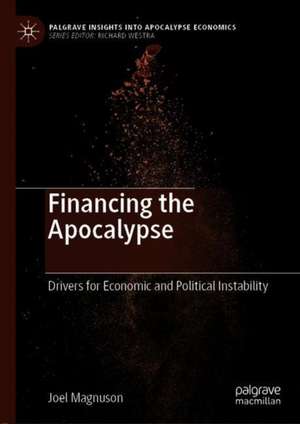Financing the Apocalypse: Drivers for Economic and Political Instability: Palgrave Insights into Apocalypse Economics
Autor Joel Magnusonen Limba Engleză Hardback – 12 ian 2019
As we tour the 400 year history of capitalism through its various phases of development, financial system instability is always there lurking in the shadows. The historical record attests that the processes of aggregating capital for real investment are inescapably vulnerable to risk, manic speculation, unserviceable debt, and crises; and with each episode of instability, a trail of devastation follows. Economic historians such as Hyman Minsky, Charles Kindleberger and others have studied this history and have exposed certain boom-bust patterns that have a way of stubbornly repeating themselves.
This book posits that the large-scale financial crises that the world has experienced over the last 30 years are more or less the latest segments in this narrative, but with some distinct characteristics. In the period spanning the stock market crash of 1987 to the banking crisis of 2008 and its aftermath – the Greenspan Era – there were key institutional and ideological developments rooted in contemporary neoliberalism that have reshaped the historic rise-and-fall patterns to become more severe and widespread. In this important volume, Magnuson suggests the next episode will be a massive financial cyclone that will send us all tumbling toward a perilous future.
This book posits that the large-scale financial crises that the world has experienced over the last 30 years are more or less the latest segments in this narrative, but with some distinct characteristics. In the period spanning the stock market crash of 1987 to the banking crisis of 2008 and its aftermath – the Greenspan Era – there were key institutional and ideological developments rooted in contemporary neoliberalism that have reshaped the historic rise-and-fall patterns to become more severe and widespread. In this important volume, Magnuson suggests the next episode will be a massive financial cyclone that will send us all tumbling toward a perilous future.
Preț: 707.00 lei
Preț vechi: 831.76 lei
-15% Nou
Puncte Express: 1061
Preț estimativ în valută:
135.28€ • 141.25$ • 111.96£
135.28€ • 141.25$ • 111.96£
Carte tipărită la comandă
Livrare economică 04-18 aprilie
Preluare comenzi: 021 569.72.76
Specificații
ISBN-13: 9783030047191
ISBN-10: 3030047199
Pagini: 328
Ilustrații: IX, 328 p. 12 illus., 11 illus. in color.
Dimensiuni: 148 x 210 mm
Greutate: 0.7 kg
Ediția:1st ed. 2018
Editura: Springer International Publishing
Colecția Palgrave Macmillan
Seria Palgrave Insights into Apocalypse Economics
Locul publicării:Cham, Switzerland
ISBN-10: 3030047199
Pagini: 328
Ilustrații: IX, 328 p. 12 illus., 11 illus. in color.
Dimensiuni: 148 x 210 mm
Greutate: 0.7 kg
Ediția:1st ed. 2018
Editura: Springer International Publishing
Colecția Palgrave Macmillan
Seria Palgrave Insights into Apocalypse Economics
Locul publicării:Cham, Switzerland
Cuprins
Chapter 1: Introduction.- Chapter 2: Taking the Long View.- Chapter 3: Fortune 500 and Wall Street Leviathans.- Chapter 4: Corporate Hegemony and the Mutual Support Network.- Chapter 5: Contemporary Neoliberalism.- Chapter 6: Everyday Neoliberalism.- Chapter 7: The Crises of the Eighties and the Ascent of the Greenspan Era.- Chapter 8: The Washington Consensus and the Epic Crises of the Nineties.- Chapter 9: The 2008 Meltdown.- Chapter 10: Microfinance and Loan Sharking.- Chapter 11: Will Peer-to-Peer and Equity Crowdfunding Be Different?.- Chapter 12: The Neoliberal Oxymoron of Green Capitalism.- Chapter 13: Conclusion.
Notă biografică
Joel Magnuson is an independent economist based in Portland, Oregon. He is the author of many books, as well as numerous articles in journals and anthologies in the United States, Europe, and Japan. His research interests include mindful economics and institutional reform.
Textul de pe ultima copertă
As we tour the 400 year history of capitalism through its various phases of development, financial system instability is always there lurking in the shadows. The historical record attests that the processes of aggregating capital for real investment are inescapably vulnerable to risk, manic speculation, unserviceable debt, and crises; and with each episode of instability, a trail of devastation follows. Economic historians such as Hyman Minsky, Charles Kindleberger and others have studied this history and have exposed certain boom-bust patterns that have a way of stubbornly repeating themselves.
This book posits that the large-scale financial crises that the world has experienced over the last 30 years are more or less the latest segments in this narrative, but with some distinct characteristics. In the period spanning the stock market crash of 1987 to the banking crisis of 2008 and its aftermath – the Greenspan Era – there were key institutional and ideologicaldevelopments rooted in contemporary neoliberalism that have reshaped the historic rise-and-fall patterns to become more severe and widespread. In this important volume, Magnuson suggests the next episode will be a massive financial cyclone that will send us all tumbling toward a perilous future.
This book posits that the large-scale financial crises that the world has experienced over the last 30 years are more or less the latest segments in this narrative, but with some distinct characteristics. In the period spanning the stock market crash of 1987 to the banking crisis of 2008 and its aftermath – the Greenspan Era – there were key institutional and ideologicaldevelopments rooted in contemporary neoliberalism that have reshaped the historic rise-and-fall patterns to become more severe and widespread. In this important volume, Magnuson suggests the next episode will be a massive financial cyclone that will send us all tumbling toward a perilous future.
Caracteristici
Expands on the established work of economic historians and integrates these new developments into a holistic, institutional framework Argues that contemporary neoliberalism in the USA from the Greenspan Era to the present has shaped our institutions and ideologies in ways that have had a profound and deleterious effect Raises the concern that these institutional and ideological developments are deepening the crisis conditions of our financial system












